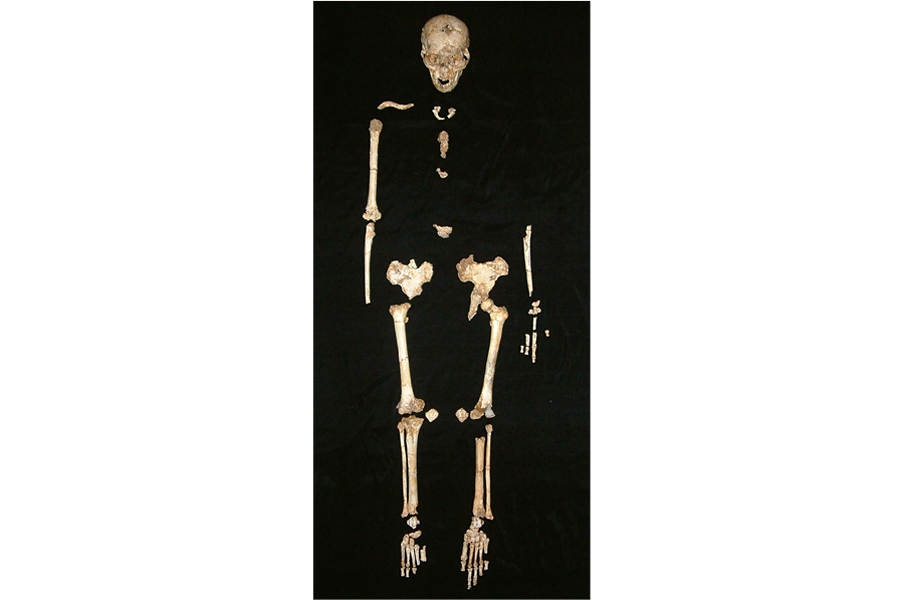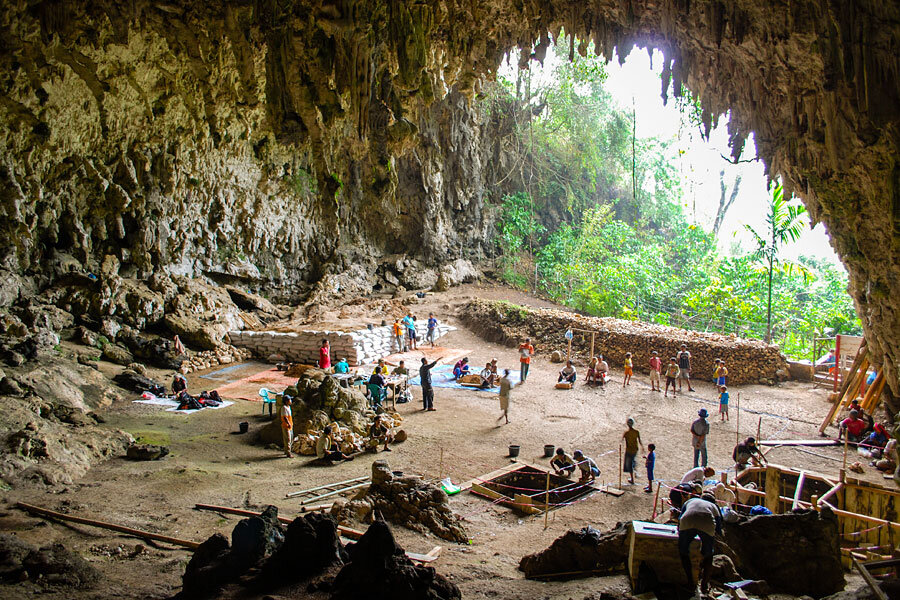Did 'hobbit' people go extinct earlier than we thought?
Loading...
Strange human fossils unearthed over a decade ago on Indonesia's island of Flores revealed the existence of an ancient, petite species of human, dubbed Homo floresiensis and nicknamed "hobbits."
At the time, researchers said that the unique, extinct, 3.5-foot-tall human may have lived as recently as 18,000 years ago, perhaps even 13,000 to 11,000 years ago. This would have made the newfound species the last remaining human other than Homo sapiens.
But now those dates have been revised. A new study argues those fossils are actually between 100,000 and 60,000 years old.
The cause of the confusion? Erosion. Researchers date fossils like those of H. floresiensis by determining how long sediment has been covering specimens. Some layers around these fossils had eroded, making it seem as though the specimens had been deposited much more recently, say a team of scientists whose revised chronology was published Wednesday in the journal Nature.
"The initial excavations were sampling very small areas," says study author Matthew W. Tocheri, a researcher at the Smithsonian's Human Origins Program, in a phone interview with The Christian Science Monitor. "You don't get to see the full picture."
It's a lot like putting together a puzzle, says Dr. Tocheri, who also teaches anthropology at Canada's Lakehead University. "If you only pull out two pieces and try to fit them together, a lot of the time the pictures that you make from that are going to be very different than after you've pulled out 15 or 20 pieces of the puzzle."
And researchers have been pulling out more puzzle pieces over the past decade.
Ever since H. floresiensis skeletons and stone tools were first found at the Liang Bua cave on Flores, archaeologists have been searching for more fossils. The cave is quite large, Tocheri says, so scientists had a lot of ground to cover.
As excavations continued, it became clear that there was some sort of boundary in the sediment right around the layer in which the initial fossils were found. The researchers investigated further and found a stratigraphic unconformity, evidence that sediment had not been deposited continuously. And that missing layer was the key.
Exhaustive excavations
But the researchers had to be sure before they announced this revision to the world. "This has really been going on for nine years," Tocheri says. "By 2010 or 2011 it started to become much clearer that there was at least a stratigraphic unconformity, so it was a matter of trying to use as many dating methods as possible. We were trying to be as thorough as we possibly could."
Ultimately the team used stratigraphy, radiocarbon dating, luminescence dating, uranium-series dating, and argon-argon dating to determine that the skeletal remains were in deposits dated between 100,000 and 60,000 years old and stone artifacts associated with these archaic humans fit somewhere between 190,000 to 50,000 years old.
"In many ways, science does correct itself. By continually investigating a site, you sometimes find minor errors that you made in the earlier interpretations and then you want to revise those interpretations," explains Russell L. Ciochon, a paleoanthropologist at the University of Iowa in Iowa City, who was not part of the study, in an interview with the Monitor.
"Although we think of determining the age of a site as just the simplest thing, it actually is pretty hard," says Michael Chazan, a paleoarcheologist at the University of Toronto who was also not part of this study.
These new findings constitute "the kind of research we've been waiting for in terms of a really well done, pretty fundamental description of how the site formed," he tells the Monitor in an interview.
Tocheri simply says, "It's part of the scientific process."
Evolving a mysterious hobbit
H. floresiensis is enigmatic in its own right, even with the revised dates.
The strange little archaic human has been nicknamed "hobbit" for its stature. But how did it come to be so small?
Two other human species are known to have reached the island region, H. erectus and our own species, H. sapiens. Both are significantly larger than the hobbits.
Scientists have suggested that this is a case of island dwarfism. In such a scenario, a human population would have arrived on the island large but shrunk over generations, thanks to evolutionary selection. Other animals, like elephants, have been found to undergo island dwarfism, but "this is the only example we have of island dwarfing of a human lineage," says Dr. Ciochon.
But which species originally settled the island?
H. floresiensis is morphologically similar to the older human species H. erectus, Tocheri says.
Furthermore, the new dates refute any hypotheses that suggest H. floresiensis was descended from anatomically modern humans, as our species didn't make it to the region until around 50,000 years ago. Perhaps the two species interacted, he says, but currently the earliest evidence of H. sapiens on Flores is from about 11,000 years ago, long after the smaller species went extinct.
An alternate explanation is that "Homo floresiensis is the descendant of another premodern species of Homo that may have been smaller-bodied and smaller-brained (e.g., like in African species attributed to early Homo) to begin with when it reached the island. Further discoveries of older hominin fossils on Flores and elsewhere in Asia are needed to resolve these questions about the ancestry of Homo floresiensis," Tocheri writes in an email to the Monitor.
The researchers point out that the revised dates apply to this site and these fossils, but if H. floresiensis fossils are discovered elsewhere, they might be younger.
"If there was a book that chronicled the entire evolutionary history of Homo floresiensis, then it would be like we have only a few tattered and torn pages with the rest of the pages missing (but hopefully not lost forever!)," Tocheri writes.
Regardless, H. floresiensis "highlights how much variation there probably was in the human family tree," Daniel Lieberman, a paleoanthropologist at Harvard University who was not part of the study, tells the Monitor in an email.
"Our genetic diversity as a family group was far more greater in the past than it is today. And that's from a genetic perspective, that's from a morphological perspective, it's from a behavioral perspective," Tocheri says. "It's easy for us to forget because we're the only ones left that can pontificate about what it means to be human."










